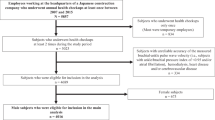Abstract
Brachial–ankle pulse wave velocity (baPWV) is a promising technique to assess arterial stiffness conveniently. However, it is not known whether baPWV is associated with well-established indices of central arterial stiffness. We determined the relation of baPWV with aortic (carotid-femoral) PWV, leg (femoral-ankle) PWV, and carotid augmentation index (AI) by using both cross-sectional and interventional approaches. First, we studied 409 healthy adults aged 18–76 years. baPWV correlated significantly with aortic PWV (r=0.76), leg PWV (r=0.76), and carotid AI (r=0.52). A stepwise regression analysis revealed that aortic PWV was the primary independent correlate of baPWV, explaining 58% of the total variance in baPWV. Additional 23% of the variance was explained by leg PWV. Second, 13 sedentary healthy men were studied before and after a 16-week moderate aerobic exercise intervention (brisk walking to jogging; 30–45 min/day; 4–5 days/week). Reductions in aortic PWV observed with the exercise intervention were significantly and positively associated with the corresponding changes in baPWV (r=0.74). A stepwise regression analysis revealed that changes in aortic PWV were the only independent correlate of changes in baPWV (β=0.74), explaining 55% of the total variance. These results suggest that baPWV may provide qualitatively similar information to those derived from central arterial stiffness although some portions of baPWV may be determined by peripheral arterial stiffness.
This is a preview of subscription content, access via your institution
Access options
Subscribe to this journal
Receive 12 digital issues and online access to articles
$119.00 per year
only $9.92 per issue
Buy this article
- Purchase on Springer Link
- Instant access to full article PDF
Prices may be subject to local taxes which are calculated during checkout



Similar content being viewed by others
References
Safar ME, London GM . Therapeutic studies and arterial stiffness in hypertension: recommendations of the European Society of Hypertension. The Clinical Committee of Arterial Structure and Function. J Hypertens 2000; 18: 1527–1535.
O'Rourke MF et al. Clinical applications of arterial stiffness; definitions and reference values. Am J Hypertens 2002; 15: 426–444.
Blacher J et al. Impact of aortic stiffness on survival in end-stage renal disease. Circulation 1999; 99: 2434–2439.
Laurent S et al. Aortic stiffness is an independent predictor of all-cause and cardiovascular mortality in hypertensive patients. Hypertension 2001; 37: 1236–1241.
Yamashina A et al. Validity, reproducibility, and clinical significance of noninvasive brachial–ankle pulse wave velocity measurement. Hypertension Res 2002; 25: 359–364.
Tomiyama H et al. Influences of age and gender on results of noninvasive brachial–ankle pulse wave velocity measurement—a survey of 12 517 subjects. Atherosclerosis 2003; 166: 303–309.
Munakata M, Ito N, Nunokawa T, Yoshinaga K . Utility of automated brachial ankle pulse wave velocity measurements in hypertensive patients. Am J Hypertens 2003; 16: 653–657.
Tanaka H, DeSouza CA, Seals DR . Absence of age-related increase in central arterial stiffness in physically active women. Arterioscler Thromb Vasc Biol 1998; 18: 127–132.
Kelly R, Hayward C, Avolio A, O'Rourke M . Noninvasive determination of age-related changes in the human arterial pulse. Circulation 1989; 80: 1652–1659.
Cortez-Cooper MY, Supak JA, Tanaka H . A new device for automatic measurements of arterial stiffness and ankle–brachial index. Am J Cardiol 2003; 91: 1519–1522.
Benetos A et al. Arterial alterations with aging and high blood pressure: a noninvasive study of carotid and femoral arteries. Arterioscler Thromb 1993; 13: 90–97.
Kimoto E et al. Preferential stiffening of central over peripheral arteries in type 2 diabetes. Diabetes 2003; 52: 448–452.
Tanaka H et al. Aging, habitual exercise, and dynamic arterial compliance. Circulation 2000; 102: 1270–1275.
Tanaka H, DeSouza CA, Seals DR . Arterial stiffness and hormone replacement use in healthy postmenopausal women. J Gerontol 1998; 53: M344–M346.
Moreau KL et al. Regular exercise, hormone replacement therapy and the age-related decline in carotid arterial compliance in healthy women. Cardiovasc Res 2003; 57: 861–868.
Mustata S, Chan C, Lai V, Miller JA . Impact of an exercise program on arterial stiffness and insulin resistance in hemodialysis patients. J Am Soc Nephrol 2004; 15: 2713–2718.
Edwards DG et al. Effect of exercise training on central aortic pressure wave reflection in coronary artery disease. Am J Hypertens 2004; 17: 540–543.
Wilkinson IB et al. The influence of heart rate on augmentation index and central arterial pressure in humans. J Physiol (London) 2000; 525: 263–270.
Acknowledgements
This study was supported in part by NIH Grant AG20966. HT was supported by JSPS invitational fellowship programme (S03701) during his stay in Japan. MCC was supported by NIH predoctoral fellowship HL072729. The vascular testing device used for the present study was provided by the Colin Corporation.
Author information
Authors and Affiliations
Corresponding author
Rights and permissions
About this article
Cite this article
Sugawara, J., Hayashi, K., Yokoi, T. et al. Brachial–ankle pulse wave velocity: an index of central arterial stiffness?. J Hum Hypertens 19, 401–406 (2005). https://doi.org/10.1038/sj.jhh.1001838
Received:
Revised:
Accepted:
Published:
Issue Date:
DOI: https://doi.org/10.1038/sj.jhh.1001838
Keywords
This article is cited by
-
Comparison of arterial stiffness indices measured by pulse wave velocity and pulse wave analysis for predicting cardiovascular and all-cause mortality in a Chinese population
Hypertension Research (2024)
-
Habitual isomaltulose intake reduces arterial stiffness associated with postprandial hyperglycemia in middle-aged and elderly people: a randomized controlled trial
Heart and Vessels (2024)
-
The effect of adverse pregnancy outcomes on vascular aging in young women: the Kailuan study
Journal of Human Hypertension (2023)
-
Effects of aerobic, resistance, and combined training on endothelial function and arterial stiffness in older adults: study protocol for a systematic review and meta-analysis
Systematic Reviews (2022)
-
The relationship between brachial-ankle pulse wave velocity and peripheral blood lymphocyte subsets in hypertensives: a cross-sectional study
Journal of Human Hypertension (2022)



